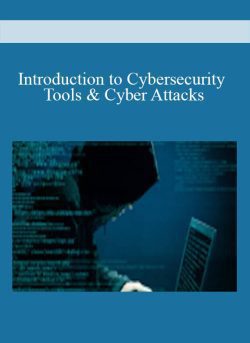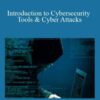$39.00
Digital Download: You will receive a download link via your order email
Save up to 85% compared to Salepage prices. In addition, earn additional points. Save more on your next order.
Please contact email: esygbteam@gmail.com if you have any questions about this course.
 Purchase this course you will earn 39 Points worth of $3.90
Purchase this course you will earn 39 Points worth of $3.90Elevate your skills with the Introduction to Cybersecurity Tools & Cyber Attacks course, available for just $39.00 on Utralist.com! Browse our curated selection of over 60,000 downloadable digital courses across diverse Everything Else. Benefit from expert-led, self-paced instruction and save over 80%. Start learning smarter today!
 Introduction to Cybersecurity Tools & Cyber Attacks
Introduction to Cybersecurity Tools & Cyber Attacks
About this Course
This course gives you the background needed to understand basic Cybersecurity. You will learn the history of Cybersecurity, types and motives of cyber attacks to further your knowledge of current threats to organizations and individuals. Key terminology, basic system concepts and tools will be examined as an introduction to the Cybersecurity field.
You will learn about critical thinking and its importance to anyone looking to pursue a career in Cybersecurity.
Finally, you will begin to learn about organizations and resources to further research cybersecurity issues in the Modern era.
This course is intended for anyone who wants to gain a basic understanding of Cybersecurity or as the first course in a series of courses to acquire the skills to work in the Cybersecurity field as a Jr Cybersecurity Analyst.
The completion of this course also makes you eligible to earn the Introduction to Cybersecurity Tools & Cyber Attacks IBM digital badge. More information about the badge can be found https://www.youracclaim.com/org/ibm/badge/introduction-to-cybersecurity-tools-cyber-attacks
WHAT YOU WILL LEARN
- Discuss the evolution of security based on historical events
- Describe key cybersecurity concepts including the CIA Triad, access management, incident response and common cybersecurity best practices.
- List various types of malicious software.
- Identify key cybersecurity tools which include the following: firewall, anti-virus, cryptography, penetration testing and digital forensics.
SKILLS YOU WILL GAIN
Information Security (INFOSEC) IBM New Collar Malware Cyber Attacks Cybersecurity
Instructor
IBM is a global company with subject matter experts in a range of job roles. The material in this course is taught by subject matter experts that are assisting our clients every day in the field at their locations, as ethical hackers and penetration testers as well as in our Security Operation Centers. These subject matter experts (SMEs) are from the United States, Costa Rica, Italy, Canada and the UK.
Syllabus – What you will learn from this course
Week 1
History of Cybersecurity
This module will give you a brief overview of the history of cybersecurity. You will also learn key terms and roles in cybersecurity.
17 videos
- Introduction to Cybersecurity Tools & Cyber Attacks – 7m
- Welcome to History of Cybersecurity1m
- Cybersecurity Definition – 3m
- Key Terms – 1m
- Security Threats – 2m
- Vulnerability Assessments – 2m
- Roles in Security – 4m
- From Ronald Reagan/War Games to where we are Today – 4m
- The Impact of 9/11 on Cybersecurity – 10m
- Cybersecurity Today – 7m
- Cybersecurity Introduction – 7m
- Things to consider when starting a
- Cybersecurity program – 1m
- What is Security? – 8m
- Additional Security Challenges9m
- Beyond Technology: Critical Thinking in
- Cybersecurity – 4m
- Critical Thinking: A Model – 8m
- Critical Thinking – 5 Key Skills – 16m
9 readings
- Earn an IBM digital badge – 5m
- Your IBM Global Subject Matter Experts – 10m
- The Insane Amounts of Data We’re Using Every Minute (Infographic) – 10m
- WiCys Organization Resources – 15m
- The SANS Institute – 1m
- OWASP – The Open Web Application Project – 1m
- ISSA – Information Systems Security Association – 1m
- FIRST- Forum of Incident Response and Security Teams – 10m
- Additional Cybersecurity Industry Associations – 25m
7 practice exercises
- Introduction to Cybersecurity Tools & Cyber Attacks – 30m
- What are We Talking about when We Talk about Cybersecurity? – 20m
- From Ronald Reagan to Where we are Today – 10m
- Cybersecurity Programs – 10m
- Cybersecurity – A Security Architect’s Perspective – 15m
- What is Critical Thinking? – 30m
- History of Cybersecurity – 30m
Week 2
A brief overview of types of actors and their motives
This module will provide you with a brief overview of types of actors and their motives. You will also understand different types of attacks and their impact on an organization and individuals. You will also learn about tools that are available to you to assist in any cybersecurity investigation.
27 videos
- Welcome to Security Attacks, Actors and their Motive – 50s
- A brief overview of types of actors and their motives – 5m
- Hacking organizations – 3m
- Major different types of cyber attacks – 6m
- Security Attack Definition – 7m
- Security services – 11m
- Security Mechanisms – 6m
- Network Security Model – 8m
- Organizational Threats – 6m
- Attacks – 6m
- Security Architecture Attacks – 3m
- Security Architecture -Attack models – 8m
- Malware and Ransomware – 3m
- Threat Examples – 1m
- Threat Protection Defined – 2m
- Internet Security Threats – Mapping – 2m
- Internet Security Threats – Packet Sniffing – 2m
- Security Threat – IP Spoofing – 1m
- Security Threats – Denial of service – 2m
- Security Attacks – Host insertions – 3m
- The Cyber Kill Chain – 5m
- What is Social Engineering? – 4m
- Social Engineering – Phishing and Vishing – 3m
- Cyberwarfare – 6m
- Cybercrime Resources – 4m
- X-Force Command Center Introduction – 2m
- Javier’s perspective on Cybersecurity Skills 1m
2 readings
- 2019 Ponemon Institute Study on the Cyber Resilient Organization – 10m
- X-Force Research – 20m
7 practice exercises
- Types of Actors and their Motives – 30m
- An Architect’s perspective on attack classifications – 20m
- Malware and an introduction to threat protection – – 30m
- Additional Attack examples today – 30m
- Attacks and Cyber resources – 10m
- A day in the life of a SOC analyst – 30m
- A brief overview of types of actors and their motives – 50m
Week 3
An overview of key security concepts
This module will describe various key security concepts that are important in any cybersecurity position. The CIA Triad will be further explained. You will also begin to learn the significance of incident response and frameworks around cybersecurity. Finally, you will get an overview of IT Governance best practices and compliance.
14 videos
- Welcome to an Overview of Key Security Concepts – 41s
- CIA Triad – Confidentiality – 2m
- CIA Triad – Integrity – 6m
- CIA Triad – Availability – 3m
- Non – Repudiation – How does it apply to CIA?- 2m
- Access Management – 4m
- Incident Response – 5m
- Key Concepts – Incident Response – 7m
- Incident Response Process – 7m
- Introduction to Frameworks and Best Practices – 4m
- IT Governance Process – 5m
- Cybersecurity Compliance and Audit Overview – 7m
- Pentest Process and Mile 2 CPTE Training5m
OWASP framework – 2m
4 readings
- OWASP Top 10 Project Findings 2021 – 15m
- National Institute of Standards & Technology – 15m
- National Initiative For Cybersecurity Education – 15m
- Computer Security Incident Handling Guide – 20m
5 practice exercises
- CIA Triad – 30m
- Access Management – 30m
- Incident Response – 30m
- Frameworks and their purpose – 30m
- Quiz: Key concepts – 35m
Week 4
An overview of key security tools
In this module, you will be introduced to key security tools including firewalls, anti-virus and cryptography. You will explore penetration testing and digital forensics. You will learn where you can get resources on industry and current threats to assist in further research around cybersecurity.
16 videos
- Welcome to an Introduction to Key Security Tools – 51s
- Introduction to Firewalls – 2m
- Firewalls – Packet Filtering – 2m
- Firewalls – Application Gateway – 4m
- Firewalls – XML Gateway – 2m
- Firewalls – Stateless and Stateful – 3m
- Antivirus/Antimalware – 1m
- An introduction of Cryptography – 5m
- Types of Cryptography – 5m
- Cryptographic Attacks – 2m
- Cryptography – a different perspective from a Security architect – 14m
- Penetration Testing Introduction – 6m
- Pentest Methodologies – 9m
- Vulnerability Tests – 4m
- What is Digital Forensics? – 4m
- Conclusion – 24s
2 readings
- Securityintelligence.com – 25m
- Incident Response and Digital Forensics: Will You Buy or Build? – 10m
5 practice exercises
- Firewalls – 30m
- Antivirus/Antimalware – 5m
- Introduction to Cryptography – 12m
- First look at Penetration Testing and Digital Forensics – 30m
- Key security tools – 25m
Delivery Method
Cultivate continuous growth with the Introduction to Cybersecurity Tools & Cyber Attacks course at Utralist.com! Unlock lifetime access to premium digital content, meticulously designed for both career advancement and personal enrichment.
- Lifetime Access: Enjoy limitless access to your purchased courses.
- Exceptional Value: Benefit from savings up to 80% on high-quality courses.
- Secure Transactions: Your payments are always safe and protected.
- Practical Application: Gain real-world skills applicable to your goals.
- Instant Accessibility: Begin your learning journey immediately after buying.
- Device Compatible: Access your courses seamlessly on any device.
Transform your potential with Utralist.com!
Related products
Everything Else
= 38 Points
Everything Else
= 81 Points
Everything Else
= 38 Points
Everything Else
= 37 Points
Everything Else
= 40 Points
Everything Else
= 43 Points
Everything Else
Brian Tracy – 21st Century Sales Training for Elite Performance
= 47 Points
Everything Else
= 56 Points




 Introduction to Cybersecurity Tools & Cyber Attacks
Introduction to Cybersecurity Tools & Cyber Attacks







